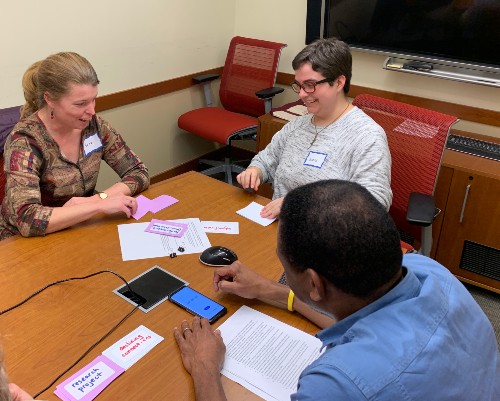By: Gregory Jost
Incubator Participant
Adjunct Professor, Sociology

In much of my work, both in the neighborhoods of the Bronx and in the classroom with my students, I strive to be a facilitator of connection, critical thinking, shared learning, and participatory design. I consider context, built through an understanding of historic arcs that have shaped the world our ancestors and we inhabit, critical to the process, on equal footing with who is in the room to engage in the conversations at hand.
I was attracted to the Reimagining Higher Education Incubator first because the invitation came from two of my two colleagues from Fordham’s Diversity, Equity and Inclusion Council, giving me assurance of the larger context in which we operate. They also asked that we come in without agendas or specific goals, and be open to an intentional process of relatedness and creation. The organizers invited faculty, administrators, students and community partners to be part of the teams, so I knew we would have a great mix of people in the room. Finally, as an adjunct professor and freelancing part-time single dad, it was also critical that they were offering us financial compensation for our time and energy.
As we moved from a phase of identifying big “wicked” problems down to the small, tangible yet meaningful ways we could take these on from our perches in and out of the University, I came across a passage from Adrienne Maree Brown that spoke to the moment we found ourselves. At the close of the previous session, one of our crew shared how she was feeling frustrated and upset about how things were leaving off, moving too fast, and perhaps feeling rushed. To begin our next session, I shared an excerpt from Brown’s Emergent Strategy that I felt would acknowledge the difficulty of our task, and ground us to move forward in our newly formed small groups.
Inspired by Octavia Butler’s writings, especially her explorations of change, adaptation, iteration and intention in the Earthseed communities in Parable of the Sower and Parable of the Talents, Brown focuses on the concept of biomimicry to guide our thinking and actions in movement work. By looking to ancient inhabitants of our planet, such as mycelium, ants, ferns, wavicles, starlings and dandelions, we see how what happens at the very small scale allows for us to take on massive problems. Mycelium, for example, is the part of the fungus that grows underground that breaks down plant matter and toxins. As the largest organism on Earth and fully out of our sights, it shows the hidden power of interconnection and detoxification. Biomimicry in this case is about looking to nature and ecosystems like mycelium for inspiration to tackle huge design challenges. How might initiatives that foster underlying connectivity and detoxification grow larger than our wildest imaginations?
My group is looking at the value of a liberal arts education given the changing 21st century workplace, while others are looking at issues such as educational equity and climate change. The process of emergent strategy frees us up to tackle the huge issues of our time in ways that start small and connect to one another. We recognize who we are, our inheritance on this planet we share, and build together, embodying the change we wish to see.
Here is a short excerpt from Emergent Strategy (pages 41-42):
Small is good, small is all. (The large is a reflection of the small).
Change is constant. (Be like water).
There is always enough time for the right work.
There is a conversation in the room that only these people at this moment can have. Find it.
Never a failure, always a lesson.
Trust the People. (If you trust the people, they become trustworthy.)
Move at the speed of trust. Focus on critical connections more than critical mass—build the resilience by building the relationships.
Less prep, more presence.
What you pay attention to grows.
